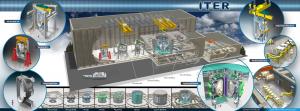Pair of safe hands to handle up to 1,500 tonnes
23 Jul 2013
-
Aris Apollonatos, Fusion for Energy
The four electric overhead travelling cranes will move between the Assembly Building and the Tokamak Building, moving the heavy components with extreme precision during assembly. © Eric Verdult 2006
Fusion for Energy (F4E), the Domestic Agency managing Europe's in-kind contribution to ITER, has signed a contract with the NKMNOELL-REEL consortium formed by NKMNoell Special Cranes GmbH, Germany and REEL S.A.S., France (part of Groupe REEL) for the design, certification, manufacturing, testing, installation and commissioning of the four cranes that will be used to assemble the Tokamak, as well as the Tokamak cargo lift that will move the casks containing components. The budget of the contract is in the range of EUR 31 million and it is expected to run for five years.
The cranes will be located within the Tokamak Building and the Assembly Building and will operate like a pair of safe hands to move the heavy components between the two areas and position them during assembly with extreme precision. The consortium will deliver two 750-tonne cranes that, in tandem, will lift up to 1,500 tonnes during assembly, two 50-tonne auxiliary cranes, and the Tokamak cargo lift.
Sophisticated engineering combined with advanced safety lifting and remote handling technologies are some of the elements that describe the nature of the work undertaken by the two companies.
How will the cranes work?
The four electric overhead travelling cranes will move between the Assembly Building and the Tokamak Building, which is divided in two areas housing the Tokamak and a crane hall above the machine.
The major heavy lifting requirements shall be met by the two 750-tonne cranes. Each will be equipped with two trolleys carrying a single 375-ton nehoist each. In total, the four 375-tonne hoists will provide a maximum lifting capacity of 1,500 tonnes—the weight of 187 London double-decker buses. The cranes shall be capable of working in tandem to provide a fully synchronized lift and precise positioning. Two auxiliary cranes of 50-tonne capacity will be used for other lifting activities, working independently of one another.
Which components?
The principal purpose of the Tokamak crane system is to lift and receive heavy components, support assembly operations, move the cryostat components, and transport the assembled vacuum vessel sectors and other major components. When the Tokamak machine becomes operational there will be no further planned use for the cranes. The 750-tonne cranes will remain parked and electrically isolated while the 50-tonne cranes will continue to be used in the Assembly Building.
How will the Tokamak cargo lift work?
The Tokamak cargo lift shaft will be located in the Tokamak Building with connecting doors to the Hot Cell. The lift will carry the casks that contain machine components. The cask is 3.7 metres high by 2.7 metres wide and 8.5 metres long—the approximate size of a London double-decker bus, weighing 60 tonnes when empty. Automated transfer systems and high tech remote handling systems will be deployed to transfer the casks between the various levels of the Tokamak Building and the Hot Cell Facility by remote control. All components involved in the transfer need to be integrated in a seamless manner.


